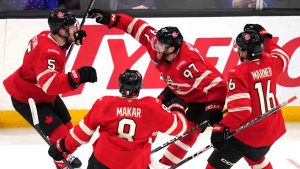BROSSARD, Que. — It was where we left off on Tuesday, after the Montreal Canadiens capitalized on only one of 37 scoring chances and lost to the Calgary Flames.
Coach Martin St. Louis had just answered a question I asked about how to attack the issue several players were having with finishing chances, saying, “We’ll look at video, but what you’re talking about is more individual stuff. Could be puck positioning, could be deception, there’s a lot of things. Could be how fast can you let it go? But that’s more individualized ... ”
When I retorted, “So, that’s not something you can really structure a practice around,” St. Louis nodded.
“Correct,” he said before adding, “but we have plenty of help on the ice with (development staff members) Adam (Nicholas) and Scotty (Pellerin) and Paulie (Byron). We’re going to keep at it.”
As head coach, St. Louis certainly works with individuals regularly.
But his primary focus, as he put it on Wednesday, is the collective.
Still, in the end, St. Louis and his staff found a way to structure a practice around finishing scoring chances, and it was fascinating to watch.
The defencemen and goalies shifted over to the first rink to work on other things, while the forwards went through these four stations to work on what St. Louis referred to as “touches around the net.”
This is my 16th season covering the NHL, and this was the first time I’ve ever seen a fair portion of a practice dedicated to that exact thing — and in such a creative manner.
I’m not sure how much it’ll help Josh Anderson, Juraj Slafkovsky, Cole Caufield, Alex Newhook, Tanner Pearson or Jesse Ylonen finish some of the chances they’ve been missing through Montreal’s first 16 games, but I don’t see how it can hurt.
I also think it was a smart thing to keep the goalies out of it — they’re going well, and St. Louis said he had no intention of exposing them to that, opting for shooter tutors instead. Doing this work to start practice before gathering the full group back together for some small-area three-on-two drills in the offensive zone was wise, too.
I saw a lot of finish in those drills immediately afterward.
And then the Canadiens finished practice working other scoring drills at those stations.
Holding this type of training session at this time of the season was also interesting, and not just to loosen the grips on sticks that are being held too tight by certain Canadiens players. The team just finished a sequence of four games in six nights, and it had put in a top-to-bottom effort and played well in each of those games, and St. Louis said, “If I make a practice where we’re going up and down the ice, you’re taking a lot of energy from the boys.”
This 45-minute workout wasn’t too physically taxing.
And it appeared to be mentally relieving.
Justin Barron’s confidence soaring
Canadiens general manager Kent Hughes mentioned several times before the season started that the progress of the group and the individuals was equally important to advance the rebuild he and executive vice-president of hockey operations Jeff Gorton have embarked on.
Both of them have to be happy on that second front with what’s happened with Justin Barron since.
The defenceman started as Montreal’s seventh after an up-and-down training camp but has emerged as a steady presence in its top-four of late, and the maturity in his game is apparent in every aspect.
Barron, who was celebrating his 22nd birthday Wednesday, told me after practice this is the most confident he’s felt at the NHL level since his debut with the Colorado Avalanche in the 2021-22 season.
I could see that for myself already.
Ironically, the reason I was speaking to him on this day — and speaking to his coach and teammates about him — was about what we see versus what we know.
St. Louis was confident what he sees in Barron already tells him everything he needs to know.
“His offensive instinct, his feet — it’s kind of all connected,” the coach said in response to a question about Barron’s best qualities as a player. “It’s the way he can move the puck, it’s the way he thinks about the game, it’s how his feet might have to do something to be able to move that puck a certain way. He really helps our offence from goal line to far blue line. But, also, inside the blue line, he’s got some really good thoughts about the way you should move the puck inside the blue line. I think all that is appreciated way more now because of the way he’s playing on the other side.”
When I asked St. Louis if any analytics provided to him helped confirm those conclusions, he said, “I trust my eye.”
I don’t know how many people in hockey have better eyes for the game than St. Louis, and his answer to the question only lent credence to that because the first thing St. Louis really dove in on was Barron’s puck movement.
In addition to that, that line about Barron really helping the offence from goal line to far blue line, really washes with the analytics.
Watching Barron recently, the thing that’s really stood out is how often his passes connect. So, late last night, I sent a note to Mike Kelly, who’s the director of analytics and insights for SportLogiq.
“Do you have a stat on Barron’s pass efficiency? Especially his breakout passes,” I asked.
Before I share what Kelly sent back, I want to share with you how Barron and Canadiens forward Tanner Pearson answered the question.
“Oh, god,” Barron started, “I don’t even know what a good percentage for that would be, but I would hope to be around 70 per cent.”
“I would say out of a 100 passes, percentage-wise, he completes 8 out of 10, so 80 out of 100,” said Pearson.
Turns out both he and Barron have a pretty good sense for what’s happening on the ice without consulting the numbers.
According to Kelly, Barron attempts 9.3 outlet passes at five-on-five per game.
His connection rate? He’s at 75.2 per cent, which is 28th among all NHL defencemen.
“That’s really good, especially for a young defenceman,” said Pearson.
It’s really good for any defenceman, but especially one consistently playing against top-six players like Barron has been over the last little while.
“It’s one of those things that I’ve always had in my game, and it’s something I pride my game on,” the Nova Scotia native said. “When I’m at my best, I’m making simple, quick plays and hopefully getting the puck out of our zone. I’m not necessarily leading the rush all the time, but I’m trying to make that first pass and then jump into space.”
Barron is accomplishing that a lot, and he’s playing a well-rounded game St. Louis encapsulated perfectly without consulting the stats.
“He’s taken a huge step this year, and I think everyone’s seen that and noticed that and he’s playing really well,” said teammate Kaiden Guhle. “I’m happy for him. I know it’s been a tough couple of years, especially being up and down last year, and he’s gotten an opportunity this year and run away with it.”
The good thing is Barron isn’t getting carried away with that. He’s staying grounded.
“I think there’s still a lot of things I can work on and keep building on,” Barron said, “but I feel I have consistency in my game right now, and I just want to keep that going.”
A fourth line St. Louis can — and should — trust
Whether it’s Michael Pezzetta or Jesse Ylonen, when either of them is playing with Jake Evans and Rafael Harvey-Pinard on Montreal’s fourth line, the results are strong.
According to St. Louis, Pezzetta was scratched from Tuesday’s game against Calgary purely because he had to get Ylonen back into the lineup.
It was the Finn’s first game since the Canadiens lost in Arizona on Nov. 2, and he didn’t disappoint, helping Harvey-Pinard and Evans control a 12-3 shot-attempt advantage and a 64 per cent expected goals edge at five-on-five.
The thing is, they played nearly two minutes less than any other line on the Canadiens against the Flames.
That’s normal, given the Canadiens were trailing 2-1 and turning to the players who are supposed to provide the offence more consistently than these three.
But the coach has found a line that can help the Canadiens sustain the waves of pressure they want to create in a game, and he’ll be wise to use it a bit more often than he has through the first 16 of the season to ensure the energy of the group remains as high as possible.
“I definitely like that,” St. Louis said on Tuesday morning about rolling his lines. “It’s hard to do with the special teams so far, but I’m confident when we’re coming in waves. I feel we’re hard to play against at five-on-five and coming in waves.”
St. Louis also said he trusts his fourth line — whether Ylonen or Pezzetta is on it — to play against top opposition, and that’s clear given he deployed it a few times against Boston’s top line of Brad Marchand, Pavel Zacha and David Pastrnak in Saturday’s win over the Bruins.
But Pezzetta played just 7:54 in that game and had the type of impact that would suggest he should be on the ice a bit more often. I mean, he had two shots, four attempts and five hits — including one massive hit on Mason Lohrei that created one of Montreal’s best scoring chances in the game — and he did all that in just 10 shifts.
In 13 shifts against Vancouver the next night, Pezzetta had another shot on net, three attempts and six more hits. He played just 9:04 in the game, but was very effective.
At the very least, it was good to hear St. Louis say Pezzetta did nothing to deserve coming out of the lineup.
And he said, “Ylo’s done nothing wrong to not have been in the lineup,” about Ylonen.
Plugging him back in works well, especially since he plays on the penalty kill and ends up averaging almost three minutes more than Pezzetta does per game.
But both of them, Evans and Harvey-Pinard, can handle more at five-on-five, and it would only help the Canadiens to give them a bit more when possible.















































COMMENTS
When submitting content, please abide by our submission guidelines, and avoid posting profanity, personal attacks or harassment. Should you violate our submissions guidelines, we reserve the right to remove your comments and block your account. Sportsnet reserves the right to close a story’s comment section at any time.